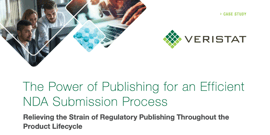Marketing Application Publishing Best Practices
ART PODCAST | SEASON 3 | EPISODE 3
In this episode of Advancing Revolutionary Therapies, Mara Holinger, Senior Vice President of Regulatory Affairs at Veristat, speaks to Kim Cohen, Principal Regulatory Operations Publisher, and Jen Harmon, Manager, Regulatory Operations, both also at Veristat, to discuss Marketing Application Best Practices from a publishing perspective.
Check out the full episode to learn more about publishing strategies to consider when planning your marketing application – or read the summary below.
What Sponsors Should Know About Publishing Marketing Applications
Jen Harmon: The first critical step for publishing Marketing Applications is holding a publishing specific kick-off meeting early in the process, which could be more than a year prior to the submission target date. During this meeting, we discuss overall timelines, rolling receipt of documents, and delivery processes, as well as highlight important milestone targets for document delivery for which the sponsor and publisher should be aligned on.
Kim Cohen: Another important part of this discussion is to ensure a basic understanding of the entire publishing process and the steps that go into making documents “submission ready,” including document-level pre-publishing, eCTD, or electronic publishing, QC processes, and final review and validation leading up to submission. We find that explaining these processes early on helps Sponsors understand how our timelines are developed and encourage teams to stay on track. A considerable number of hours are required for publishing due to the extensive number of documents and files that are part of a marketing application.
Mara: Marketing application submissions can get complex – can you share an example about the size of an NDA or BLA that you’ve seen in the past?
Jen Harmon: An NDA we previously submitted came in at a whopping 8.3 GB, containing about 2,700 files. The Module 2 sections alone contained about 1500 hyperlinks, all of which, of course, needed to be created and QC’d by our publishing team. Another important item to consider is establishing the sponsor reviewers and decision makers as early as possible. We recommend a primary sponsor contact, but if that isn’t feasible, a point of contact for each module is acceptable. Overarchingly, good communication is the key to a successful submission.
Regular Communication is Essential for a Successful Submission
Mara: What do you consider to be the best strategy to facilitate regular communication?
Kim Cohen: The best strategy for a successful marketing application submission is to have regular team meetings. These may start less frequently in the beginning of development and then increase to weekly as we get closer to submission.
Mara: Do all points of contact need to attend these meetings or could you have representatives for each module?
Kim Cohen: We’ve seen it both ways, where all the contacts attend, or we have module specific meetings, such as CMC, non-clinical, and clinical. We’re flexible to accommodate the sponsor’s preference, as we understand how limited everyone’s time is, so more focused meetings may be appropriate. With that said, however, it's important that a primary sponsor contact attends all publishing meetings. This helps manage all the moving pieces of a marketing application on the sponsor’s side.
Jen Harmon: During these team meetings, we’ll populate a table of contents tracker for each module. Publishers rely on this tracker to build the submission, so it is important that the content aligns with the sponsor’s expectations.
Kim Cohen: Once the module contents are defined, we use our meetings to track timelines for final documents and make updates for any content changes. This allows us to identify late breaking components and plan accordingly, as many documents are “linked” together and a delay in one can have a trickle effect on others, especially if there are external hyperlinks needed.
Publishing Timelines and Preparing for Unexpected Program Delays
Mara: Let’s discuss some examples on how the Veristat team has previously mitigated timeline delays.
Kim Cohen: When this happens, we review the updates with the sponsor and try replacing only individual pages, versus the entire document, allowing us to save time with QC and preserve most external hyperlinks. This approach does not always work, as it is dependent on the extent of the updates, however, we try to do this whenever possible.
Jen Harmon: In this case, we add placeholders in the eCTD backbone for documents that we know will be late. This allows us to create the necessary external hyperlinks and then once we receive the final version, we simply replace the placeholder document, and the external hyperlinks stay intact.
Kim Cohen: These strategies help avoid significant timeline delays. One additional, simple way to reduce timeline delays is to leverage previously submitted materials as these would have already been formatted and pre-published to guidance specifications. These documents can be provided from either the sponsor’s third-party publisher, if applicable, or from the actual agency submissions. Overall, this saves time with pre-publishing and QC. Lastly, if we are aware of late breaking documents, we can add resources to ensure the final submission stays on track. Communication is key throughout the marketing application process!
Mara: Can you speak a bit more about typical publishing timelines for marketing applications?
Jen Harmon: Our timelines are determined by a few factors, but the most critical is delivery of documents to publishing on a rolling basis. In fact, we prefer to begin receiving documents as soon as the publishing kickoff meeting occurs, 8-12 months prior to submission. We encourage sponsors to send final documents as soon as possible. In our experience, the final push where multiple publishers get involved usually occurs in the last 4-6 weeks.
Mara: What other timeline considerations should Sponsor’s keep in mind?
Kim Cohen: Another timeline consideration is the state of documents when they arrive to publishing. At Veristat, we are accustomed to guiding small and midsize Sponsors through the submission process, including document formatting. To achieve consistency across all documents and modules, we recommend authoring in an eCTD template suite. This helps reduce formatting time and ensures a cohesive application.
Jen Harmon: It is also important for Sponsors to indicate where they want links to external documents. This will help eliminate any guess work for publishers and facilitate smooth publishing and QC processes.
Kim Cohen: One additional recommendation is for the sponsor and publisher to decide on a depository for final documents. This helps signal to the publisher that a document has undergone its required internal Sponsor checks and is approved for publishing. It’s critical to maintain proper version control throughout the process, and keeping final documents separate from previous drafts is a must.
Publishing Best Practices for Marketing Applications
Mara: Can you speak a bit more about typical publishing timelines for marketing applications?
Absolutely. Our timelines are determined by a few factors, but the most critical is delivery of documents to publishing on a rolling basis. In fact, we prefer to begin receiving documents as soon as the publishing kickoff meeting occurs, 8-12 months prior to submission. We encourage sponsors to send final documents as soon as possible. In our experience, the final push where multiple publishers get involved usually occurs in the last 4-6 weeks.
Mara: The process requires time and dedication from publishers and the Sponsor. What other timeline considerations should Sponsors keep in mind?
Kim Cohen: Another timeline consideration is the state of documents when they arrive to publishing. At Veristat, we are accustomed to guiding small and midsize Sponsors through the submission process, including document formatting. To achieve consistency across all documents and modules, we recommend authoring in an eCTD template suite. This helps reduce formatting time and ensures a cohesive application.
Jen Harmon: It is also important for Sponsors to indicate where they want links to external documents. This will help eliminate any guess work for publishers and facilitate smooth publishing and QC processes.
Kim Cohen: One additional recommendation is for the sponsor and publisher to decide on a depository for final documents. This helps signal to the publisher that a document has undergone its required internal Sponsor checks and is approved for publishing. It’s critical to maintain proper version control throughout the process, and keeping final documents separate from previous drafts is a must.
Mara: Are there any best practices for a successful marketing application submission from a publishing perspective?
Jen Harmon: I’ve hinted at this before, but publishing Module 4 and completed Module 5 CSRs first is typically the best place to start. This has become a best practice for a few reasons, but largely because these are the foundation for Module 2 linking and contain the bulk of reports. Both can also be approved earlier in the publishing process, leaving time for late arriving components.
Kim Cohen: Another critical piece of Modules 4 and 5 is obtaining submission-ready datasets as early as possible. With ever-changing technical requirements and the risk of rejection at the gateway, it is important to work closely with the publisher to ensure requirements are met. For Sponsors who may need additional dataset review or support, we can engage our Biostats and Programming team for further guidance, if needed.
















